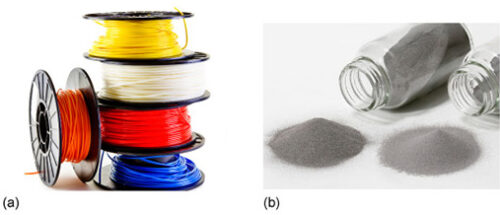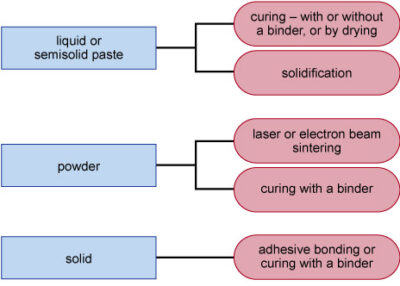
ROHINUR
The build process often consists of several substeps:
Material needs to be added to the substrate in some form. Depending on the specific AM technique, the method of adding material varies. The most common forms of consumables are wires, resins and powders. The basic requirement is that a small, well-controlled amount of consumable needs to be delivered to a specified position.
For most techniques the consumable needs to be produced specially – you can’t simply use any powder or wire. The choice of consumables can have a considerable influence on the final properties of a part. For instance, the shape and size of the grains of metal have been found to influence the melting properties of the powder. The interaction of a laser with a spherical powder grain is different to that with an irregular-shaped grain.
Figure 11 shows some example consumables.

Figure 11(a) shows five spools of filament of varying colours. Figure 11(b) shows two containers of titanium powder of different grades
As material is delivered, it is consolidated in some way. This can be a melting and solidification process, or a curing process in the case of polymeric systems. Quite often, when melting is required, lasers are used because of the high-energy input and narrow beam. The delivery and consolidation of material is specific to the technology being used. Figure 12 gives an overview of the methods used to consolidate different kinds of consumables.

Diagram showing consumables and the associated methods of consolidation. For liquid or semi solid paste, the associated methods are curing – with or without a binder, or by drying; or solidification. For powder the associated methods are laser or electron beam sintering or curing with a binder. For a solid, the associated methods are adhesive bonding or curing with a binder.
Terminology derived from rapid prototyping (RP) defines a system as either a one-dimensional (1D) or two-dimensional (2D) system depending on how the new material is added. All modern AM machines use a 1D system, delivering points of material to create a layer of material in the desired contour.
Two-dimensional systems were common in RP, where entire layers were created in a single step – for instance with a paper or plastic sheet. In 2018, none of the 2D RP systems had been commercially developed adequately to be considered as AM systems. Therefore, only 1D systems will be considered in the rest of this course – but you should appreciate the general situation.